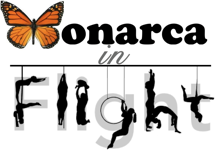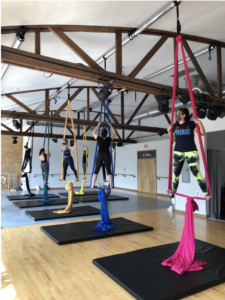Traincations 101: Dos and Don’ts of Visiting a New Studio
Photo: Aerial Dance Chicago
The weather is getting warmer and Covid finally seems to be settling down (knock on wood!), so as we start dreaming about summer vacations and weekend getaways, you may also be thinking about how to keep your aerial training going while away from Monarca. So, over the next few newsletters, we’ll do a “Traincations 101” series! The portmanteau “traincation” usually refers to vacations taken specifically for aerial training, but a lot of this information will apply even if you’re just dropping into a new studio for some airtime during a family vacation or business trip.
First up, we’ll cover some Dos and Don’ts when you visit any new studio, whether it’s for one class, a week, or even a month or more. Our local coaches are great, but it’s always exciting when you get to check out a new area and learn new things from new coaches – maybe you’ll even get to train with someone whose Instagram posts you’ve admired! Here are some tips to help you get the best experience possible:
DO research your destination and local studios beforehand! Some studios only use “session” formats and don’t allow drop-ins, and most studios have prerequisites. DON’T be afraid to give them a call or send them a DM to ask any questions you have and find out what your options are (if you can’t get into a group class, do you want to take a private? Or maybe you’re getting ready for a showcase and just need some open studio time), and DO have some videos ready to show them so they can assess your skill level! You might even be able to reach out to specific instructors if you have questions about a particular class, so DO plan ahead as much as you can – don’t expect them to be able to schedule a private lesson for you on 2 days’ notice. Two personal stories:
- I once reached out to Suze Curry (the #dropqueen) about a class which I thought might be too advanced for me – I was only in town for a few days and that was the only class I could make, and I REALLY wanted to train with her. She told me she would normally put me in a lower class, but then told me to come anyway because she wasn’t teaching anything too crazy! It was a win/win (although I think I won a little more than she did) – Suze was able to plan ahead for having me in class, and I got to learn an AMAZING stacked drop that we could never do at Monarca (due to height)!
- When I was in Taiwan, I reached out to aerial studios to ask if they spoke English! I do speak some Chinese, and luckily, aerial skills are easy to learn visually, but it was helpful to know which language class would be taught in – and for them to know that I might not have much aerial vocabulary in Chinese. (Fun fact: in class, we would say “jiayou” to encourage each other. The literal translation is “add fuel,” as in stepping on the gas pedal, but basically it means “go for it” or “you can do it!”)
DO know some basic safety guidelines to look out for when you first walk in the door. It’s exciting to be somewhere new, but if their rigging looks sketchy or there’s not a mat to be seen, DON’T be afraid to ask questions about their safety measures – politely, of course! You don’t need to assume the worst – maybe their mats are just tucked away to create extra floor space for warming up. But any studio or coach worth their salt should welcome questions around safety and be able to answer them easily. And yes, every studio should provide a safe environment, but DO remember that your safety is always YOUR OWN responsibility. DON’T be afraid to leave if you feel unsafe even after you’ve talked to the staff and asked questions. A few things to keep in mind:
- Rigging points are hard to eyeball, but if it looks like they’re rigging from TRX mounts or anything that looks like you could have installed it into your own ceiling at home in under 10 minutes, you should ask about it. Our rigging points at Monarca are engineered to support the weight of a small car, which is a good rule of thumb.
- Crash mats (preferably at least 8” thick – the same thickness we use at Monarca) should be available and in active use, especially when working at height and/or inverting. Again, they might not be laying around 24/7, but if you’re taking an aerial class, they should come out when you get in the air.
- Rescue plans aren’t always obvious, but take a look around: does it look like they would be able to get you down easily if you got stuck at height? Some obvious signs would be ladders or pulley systems. Again, just because it’s not obvious doesn’t mean they don’t have a [good] one – maybe their ladder is just in a closet. And maybe if you’re taking a flexibility class, you’re not too worried about their rescue plan – but they should still be able to tell you about it if you ask.
DON’T assume you will “click” with every coach. This can happen for many reasons, so DO think critically about it. Every coach has a different style, and sometimes it takes a few classes for them to figure out how best to work with you. Or they might be asking you to step outside your comfort zone in a new way. Or, sometimes you may feel uncomfortable because you actually don’t feel safe. DO raise your hand if that’s the case – let the instructor know what’s not working for you and ask them for a different cue, a modification, or an alternative. DON’T be afraid to sit out a skill if you gave it an honest try and it’s just not working, but DO be polite and respectful if that happens!
DO arrive early! This allows you to get your bearings in a new space, maybe meet some new aerialist friends, and introduce yourself to the instructor. DO be honest and transparent about your skill level, injuries, and anything else the coach might need to know to give you appropriate progressions and help you stay safe.
DON’T forget to pack any crucial aerial gear (e.g., leggings and a leotard!) even if you haven’t made concrete plans to take a class yet. Your schedule could change, or you might see something cool on social media at the last second. DO keep the weather and climate in mind and pack appropriately – you won’t want to wear your thickest, stickiest leggings in 90% humidity.
DO take notes (and videos if you can)! You might learn a new name for something you already know, or a new version of an old skill, or something entirely new to you. Since aerial gets passed from person to person and skills can vary regionally, it’s important to be able to give credit where credit’s due. So DO tag your host studio and/or instructor if you post on social media, and whenever you share skills, DO say where you got them!
DON’T assume their studio etiquette will be the same as Monarca’s. This can be tricky because many of these norms happen organically, so they’re not written anywhere. Remember that you’re a guest, so DO watch what’s going on around you and take your cues from other students so you don’t disrupt class. Some examples:
- During class, watch how other students behave when they’re not in the air – Monarca has gotten more casual over the years, but some studios (or even specific coaches) are more formal. They might ask students not to sit down during class. Small talk and phone use may or may not be allowed. There might even be a specific spot for you to sit or stand when not actively in the air (especially if the space is small).
- Grip aid etiquette also varies. Some studios don’t allow chalk or rosin on shared apparatuses. If they do, there might be a designated area for you to chalk up so it doesn’t get everywhere.
- Some studios are more or less comfortable with exposed skin for various reasons. It could be that you’re in a particularly conservative area, or maybe they just don’t want people’s bare sweaty skin all over shared apparatuses. Consider erring on the conservative side – even if you normally train in booty shorts and a sports bra.
- Every studio’s policy on photos and videos may be different. Always ask if it’s ok to video, especially if you want to video a coach OR if other students will be in the background of your video.
DO check out the studio’s ground-based or other offerings that we may not have at Monarca! This might be your golden opportunity to try cloud swing, cyr wheel, unicycling, or another new and exciting discipline!
DON’T forget to buy a t-shirt or other studio swag (if you want)! Swag isn’t just a fun collection to remind you of your traincation – it also helps support the studio that so graciously hosted you! By the same token, DO rep Monarca (if you feel so inclined) – you can do this by wearing a Monarca shirt to class or even just mentioning us when you say where you’re from! We’d love to return the favor for any visiting aerialists coming to the DC area!
DO continue working on your new skills once you come back to Monarca! Please DO also chat with Monarca coaches about the skills you’re working on so we can be prepared to provide guidance and spotting as needed. Some skills may also be new to us (how exciting!), so we’ll need a chance to figure them out before we can help you with them.
Visiting new studios helps us keep the circus community growing and evolving! It’s also one of the best ways to keep our aerial brains fresh and keep us exploring new skills and ideas. We can’t wait to see what you bring back with you from your travels!
-Sophia Chen

